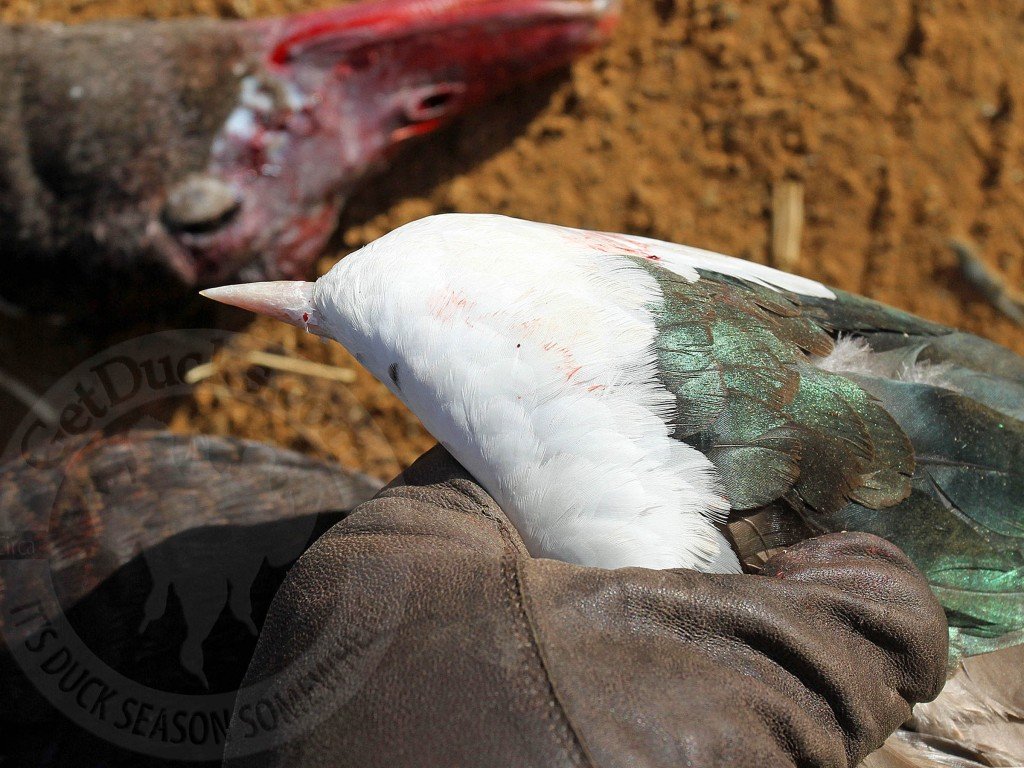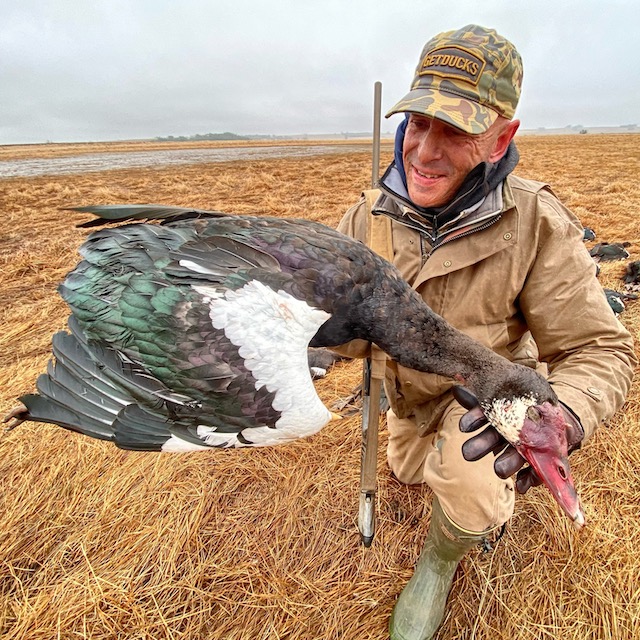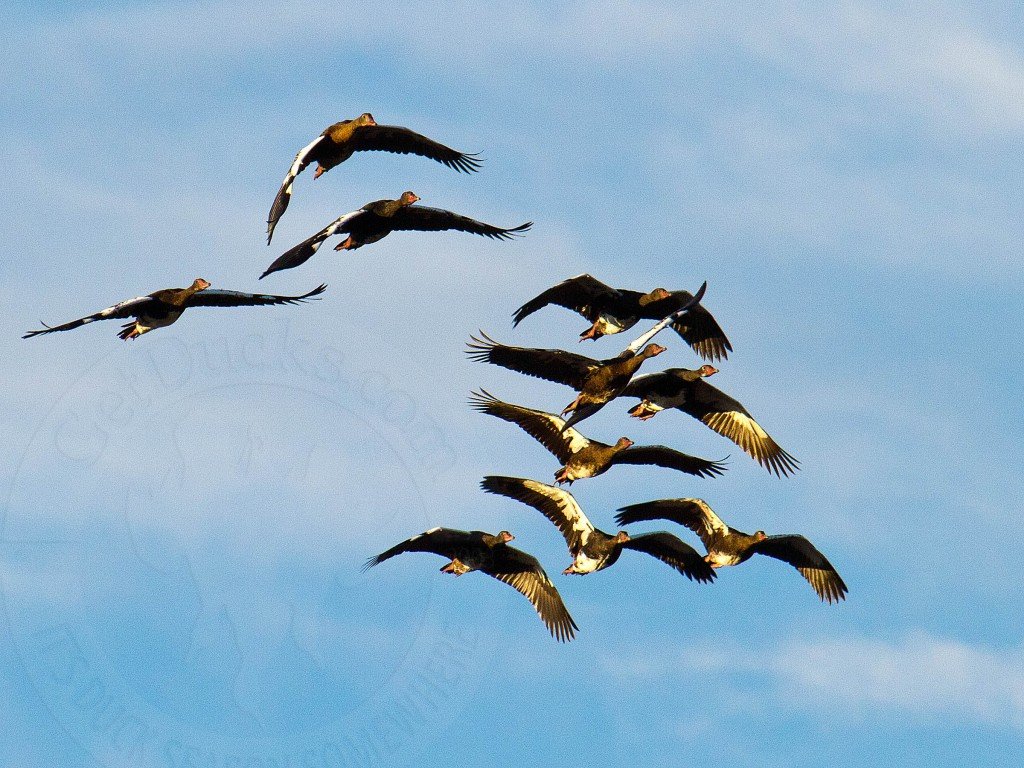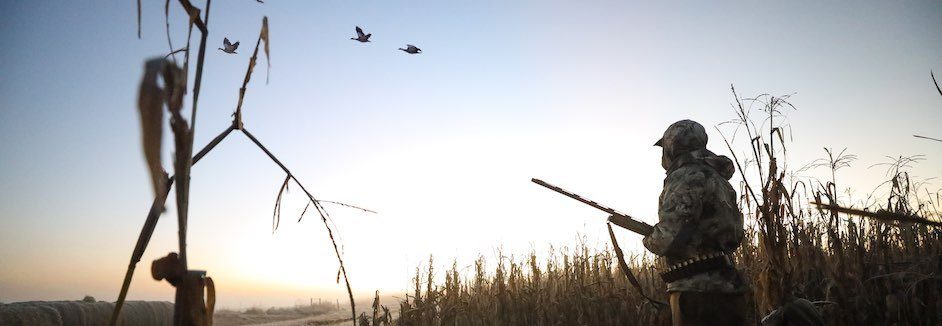Spur-winged Goose
Spur-winged Goose (Plectropterus gambensis) are the largest species of waterfowl found in Africa. While assigned in the family Anatidae, this waterfowl species has enough distinct anatomical features that are not found in other geese and shelducks that they are considered their own subfamily, called Plectropterinae. Males have a large and long red bill that matches the featherless skin that extends above and below their eyes. Then they have a patch of white plumage, followed by a long, black neck. Wing plumage is black with iridescent greens, yellows, chestnut, and sometimes purple. Breast and underbelly are typically white. When seen in flight, the underside of the primaries and secondaries are black, with the rest of the wing being bright white. Females can have a similar featherless head/cheek area, and have copper plumage on the rest of their head, neck, and breasts. The most important and interesting feature of the Spur-winged Goose is its namesake, the spur on the bend of their wings. These spurs can be used for territorial disputes, especially during the breeding season when they are at their most aggressive.

SPUR-WINGED GOOSE. The meanest ugliest SOB’ing goose on earth is also the largest. They’re among the baker’s dozen waterfowl species we shoot in South Africa, where we also hunt African pygmy goose, the worlds smallest goose!
Available Hunts
Spur-winged Geese are the world’s largest wild “goose”, although in average weight, their size is at least rivaled by the Cape Barren goose of Australia. Spur-winged geese appear to be more closely allied to shelgeese than “true geese” such as those from the Branta genera. This is generally a quiet species. Typically, only males make a call, which consists of a soft bubbling cherwit when taking wing or alarmed. During breeding displays or in instances of alarm, both sexes may utter other inconspicuous calls.
Spur-winged Goose have a defined breeding season that can vary by time of year and length by their location. In Northern Africa, breeding spans from August to December, Eastern African birds breed from January to June, and Southern African birds breed from August to May. Spur-winged Goose pairs have large nests that are most often in dense vegetation near water sources, but also use tree holes, rock crevasses, abandoned nests, or aardvark burrows to lay their eggs.
Spur-winged Geese can be found in rivers, lakes, and swamps in sub-Saharan Africa. Saline waters and arid landscapes are not commonly used by this species. The majority of their diet consists of seeds from grasses and sedges, grains from agricultural fields, and plant tubers. Intake of invertebrates are typically incidental and intake of small fish are supplemental. This goose is often poisonous due to its diet of blister beetles. The poison, cantharidin, is held within the tissue of the fowl resulting in poisoning of those that eat the cooked goose–but not a single hunter or guide in South Africa has ever heard of such a preposterous thing happening!

SPUR-WINGED SEND-OFF. They approached from the south, across a landscape resembling peanut field Oklahoma, silently beating it against the stiff wind. White forewings and bellies contrasting with black bodies, long wing strokes creating illusion of lapping waves coming ashore. Spotting oversized hand-made silouhettes drifted behind our blinds, they seemed to approach in slow motion. It’s an optical illusion due to their size. They’ve been clocked at 88mph, faster than canvasbacks and red-breasted mergs. Africa’s largest waterfowl and the largest goose in the world, rivaled only by Australia’s Cape Barren Goose, spur-winged geese are big, mean, and ugly as they come, streaming through the air larger than life like Panzer Tanks. Waiting until they were overhead, Benelli blazing, @bossshotshells 3-inch 3s clobbering like wrecking balls, ground trembling underfoot as they crashed in orange dust plumes. Adult males average 15-16 pounds, some getting larger, red bills and wattled, bare-skin foreheads, pinkish paddles nearly the size of my own hand. Hoisting for a good look-see, menacing carpal spurs as sharp as cat claws for which this unique African waterfowl species and world’s largest goose is aptly named. Happy clients headed home, incoming clients somewhere over the Atlantic. SPUR-WINGED GOOSE. The meanest ugliest SOB’ing goose on earth is also the largest. They’re among the baker’s dozen waterfowl species we shoot in South Africa, where we also hunt the worlds smallest goose! Link in bio to see South Africa short film. One more week of real work stuff at @official_sci convention, and then the odyssey continues. Come by and see us at the worlds greatest hunting show booth 1059 if you’re around, and call or text if you’d like the last spot on upcoming hosted South Africa waterfowl safari this August.








